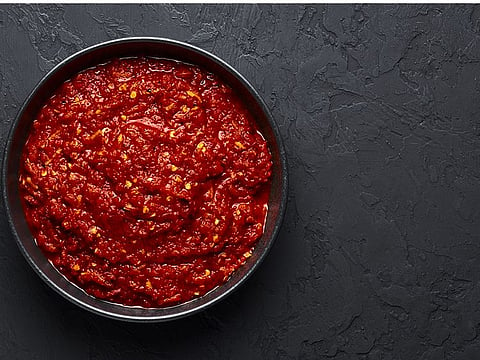From Sichuan to Kolkata: A Schezwan journey
A tale of immigration and Indo-Chinese cooking

Dubai: Schezwan sauce: Fiercely spicy with a hint of sweet, usually served with dumplings. Most of us would have tasted it at one point or another, especially if you are from the Indian sub-continent, where it is a firm belief that it’s an authentic Chinese-origin condiment. Nothing could be further from the truth!
Food bloggers often say that Schezwan sauce originated from Sichuan, a southern Chinese province. Food by Gulf News spoke to Chinese expatriates in the UAE to get to the bottom of this mystery.
Dubai-based Hui, a Chinese expatriate from the southwestern Sichuan province of China, said: "I think the schezwan sichuan sauce is inspired by Sichuan Pixian Douban (Pronounce as Shia Du-baan), a spicy bean sauce or a paste. It is usually used for cooking. If you have heard of Mapo Tofu – tofu set in a spicy sauce, typically a thin, oily, and bright red suspension, along with minced meat, which is traditionally beef... the pixian douban paste is the core ingredient."
The paste gets its name from the variety of peppercorns it uses – the Sichuan peppercorns. They are not peppers, but their petite shape is similar to peppercorns. They are berries of the prickly ash tree.
According to celebrity Indian chef Ranveer Brar's video, the first-ever schezwan recipe was adapted by a Chinese origin Indian chef Penpa Tsering, at Sampan Chinese Restaurant, Novotel, Mumbai, India, roughly 30 years back.
Perhaps, but there’s an older story, linked to Chinese immigrants in Kolkata, West Bengal. Apparently, nearly a century ago when they arrived to set up the leather business in the city, they gifted India the delicious fusion called Indo-Chinese cuisine. Among the tanneries and bylanes of Tangra are now famed restaurants serving uniquely Indian dishes such as Manchurian and Schezwan. The people who created this culinary stream are the Hakka people. You can choose either origin tale but Kolkata’s position as prime driver of Indo-Chinese cuisine is indisputable.
So, how does the sauce get its name?
The sauce's name, as explained earlier, is based on its origin – Sichuan, a southwestern province in China that is popular for its unique cooking style. They use a complex yet sophisticated style so unique that Sichuan's capital city Chengdu was recognised as UNESCO's (United Nations Educational, Scientific and Cultural Organization) the second-ever City of Gastronomy. They have brought dishes like hot-pot and mapo tofu to the global stage.
For 36-year-old Hu Xiaohong (Jane), a Chinese expatriate based in Ajman, the name schezwan sauce did not sound familiar. She explained: "I do not think we use this but what I think is the closest to this sauce is the douban paste that we use, but not as a dipping sauce, rather a cooking paste. Every family has its recipe, but flavours may vary. For instance, my mother and I make the same recipe, but the taste of our douban varies." Her husband, Deepak Venugopal, a food enthusiast and traveller who has been to Sichuan, added: "The schezwan sauce that we taste here in the UAE, is heavily adapted. Ninety per cent of the restaurants serve the same kind. The one I had in Sichuan tastes completely different. Even a small bite will be so tantalising. It is also not common to use this sauce as a dip, as a raw ingredient."
I do not think we use this but what I think is the closest to this sauce is the douban paste that we use, but not as a dipping sauce, rather a cooking paste

Putting schezwan sauce on the global map
What makes the schzewan dipping sauce so popular across the globe is the spicy flavour; in an article published by thedailychina.org, the American fast food chain McDonald's first introduced Schezwan dipping sauce, globally, in collaboration with Disney and their then-new movie Mulan. It was inspired by the region's (Sichuan) cuisine's spicy flavours. However, in traditional Chinese households, the spicy sauce or how it is called 'paste', is often used to stir-fry and in the cooking process.
Try a version of this sauce with this recipe.
Sign up for the Daily Briefing
Get the latest news and updates straight to your inbox



